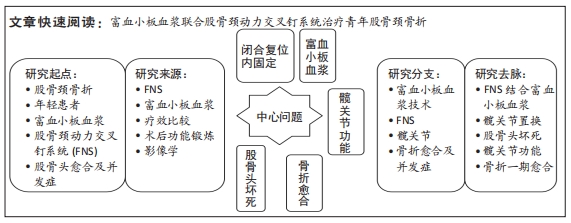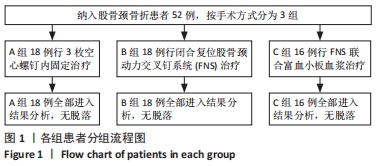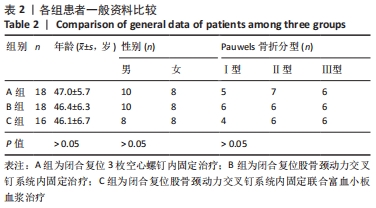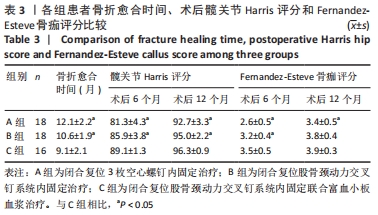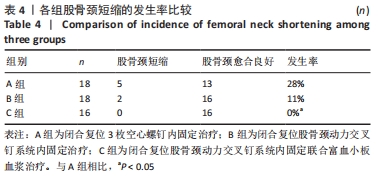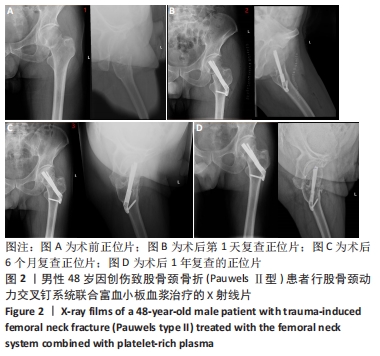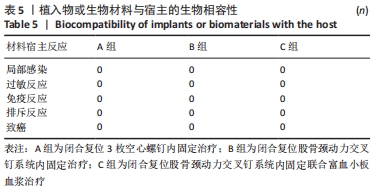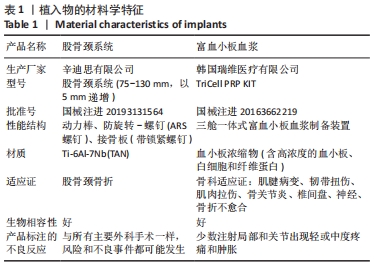[1] FLORSCHUTZ AV,LANGFORD JR,HAIDUKEWYCH GJ,et al.Femoral Neck Fractures: Current Management. J Orthop Trauma. 2015;29(3):121-129.
[2] 赵勇,秦伟凯.重视股骨颈骨折的评估与内固定治疗的若干问题[J].中国骨伤,2021,34(3):195-199.
[3] 张长青,张英泽,余斌,等. 成人股骨颈骨折诊治指南[J]. 中华创伤骨科杂志,2018,20(11):921-928.
[4] SLOBOGEAN GP, SPRAGUE SA, SCOTT T, et al. Complications following young femoral neck fractures. Injury. 2015;46(3):484-491.
[5] SCHOPPER C, ZDERIC I, MENZE J, et al. Higher stability and more predictive fixation with the Femoral Neck System versus Hansson Pins in femoral neck fractures Pauwels II. J Orthop Trans. 2020;24:88-95.
[6] WU PIK, DIAZ R, BORG-STEIN J. Platelet-Rich Plasma. Phys Med Rehabil Clin N Am. 2016;27(4):825-853.
[7] 田艳萍,李涓,刘小菠,等. 富血小板血浆5年国内外研究成果文章可视化的知识网络图谱分析[J]. 中国组织工程研究,2021, 25(11):1745-1752.
[8] 福嘉欣,王树森. 自体富血小板血浆治疗骨关节与运动损伤疾病的机制与应用[J]. 中国组织工程研究,2017,21(30):4908-4914.
[9] KRAEUTLER MJ, GARABEKYAN T, MEI-DAN O. The use of platelet-rich plasma to augment conservative and surgical treatment of hip and pelvic disorders. Muscles Ligaments Tendons J. 2016;6(3):410-419.
[10] GRASSI M, SALARI P, MASSETTI D, et al. Treatment of avascular osteonecrosis of femoral head by core decompression and platelet-rich plasma: a prospective not controlled study. Int Orthop. 2020;44(7): 1287-1294.
[11] 向登,林炎水,贺军,等. 富血小板血桨对股骨颈骨折愈合及股骨头坏死治疗效果的影响[J]. 西部医学,2017,29(1):103-105.
[12] BARTONICEK J. Pauwels’ classification of femoral neck fractures: correct interpretation of the original. J Orthop Trauma. 2001;15(5):358-360.
[13] 陈志军,杨彪,张大华. PRP联合闭合复位空心螺钉内固定治疗股骨颈骨折[J]. 局解手术学杂志,2016,25(3):195-198.
[14] 周洋洋,芮云峰,鲁攀攀,等. 多学科协作诊疗模式在老年髋部骨折临床应用中的研究进展[J]. 中国修复重建外科杂志,2020,34(1): 132-138.
[15] 王斌,邓高鹏,林正坚,等. 闭合复位空心螺钉内固定结合富血小板血浆注射治疗中青年股骨颈骨折的多中心临床研究[J]. 临床和实验医学杂志,2021,20(12):1287-1290.
[16] 庄至坤,许志庆,郭金花,等. 中青年股骨颈骨折内固定术后股骨头坏死的相关因素[J].中国矫形外科杂志,2018,26(22):2044-2049.
[17] 刘刚,刘卫东,张猛,等. 股骨颈骨折多枚空心加压螺钉内固定术后股骨头坏死的影响因素分析[J]. 局解手术学杂志,2021,30(6): 506-510.
[18] 陈翔,魏东,赵瑞鹏,等. 富血小板血浆联合空心螺钉内固定治疗股骨颈骨折疗效的Meta分析[J]. 中国组织工程研究,2020,24(3): 469-476.
[19] 周述清,朱秋汶,申洪全,等.股骨颈骨折内固定治疗的生物力学研究进展[J].创伤外科杂志,2020,22(5):391-394.
[20] 魏俊杰,叶小东. PRP联合闭合复位空心螺钉内固定对股骨颈骨折的治疗作用研究[J]. 中外医学研究,2019,17(26):159-161.
[21] HU H, CHENG J, FENG M, et al. Clinical outcome of femoral neck system versus cannulated compression screws for fixation of femoral neck fracture in younger patients. J Orthop Surg Res. 2021;16(1):370.
[22] STOFFEL K, ZDERIC I, GRAS F, et al. Biomechanical Evaluation of the Femoral Neck System in Unstable Pauwels III Femoral Neck Fractures: A Comparison with the Dynamic Hip Screw and Cannulated Screws. J Orthop Trauma. 2017;31(3):131-137.
[23] 杨晓强,薛继钊,郑程,等. 青壮年股骨颈骨折的内固定治疗进展[J]. 中医正骨,2021,33(7):38-44.
[24] 严才平,王星宽,向超,等. 股骨颈动力交叉钉系统与空心加压螺钉治疗中青年股骨颈骨折的疗效比较[J].中国修复重建外科杂志, 2021,35(10):1286-1292.
[25] 殷浩,周恩昌,潘政军,等.4枚空心钉与3枚空心钉结合支持钢板内固定治疗Pauwels Ⅲ型股骨颈骨折的有限元分析[J].中国组织工程研究,2019,23(32):5133-5137.
[26] 胡翔,刘保健,温孝明,等. 闭合复位加压空心螺钉内固定治疗中青年股骨颈骨折的疗效观察[J]. 中国骨伤,2018,31(2):111-114.
[27] 汤其元,马亚萍,张斌,等.骨组织再生工程中富血小板血浆的应用与研究进展[J].中国组织工程研究,2019,23(4):597-605.
[28] ORYAN A,ALIDADI S,MOSHIRI A.Platelet-rich plasma for bone healing and regeneration. Expert Opin Biol Ther. 2016;16(2):213-232.
[29] LI H,HICKS JJ,WANG L, et al. Customized platelet-rich plasma with transforming growth factor β1 neutralization antibody to reduce fibrosis in skeletal muscle. Biomaterials. 2016;87:147-156.
[30] 黄巍峰,许永秋,王鹏云,等. 自体富血小板血浆对前交叉韧带重建术后腱骨愈合的影响[J].实用临床医药杂志,2021,25(12):28-31.
[31] 邢飞,段鑫,陈家磊,等.术中局部应用富血小板血浆治疗成人股骨颈骨折有效性和安全性的Meta分析[J].中国循证医学杂志, 2019,19(12):1453-1459.
|
